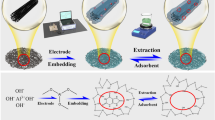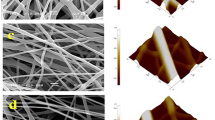Abstract
The development of antifouling surfaces is essential for many biomedical applications such as diagnostic assay materials, biosensors, blood contacting devices, and other implants. In this study, a facile one-step surface modification strategy to modify inorganic and organic substrate surfaces by dopamine-assisted immobilization of partially hydrolyzed poly(2-methyl-2-oxazoline) [P(MOXA-co-EI)] was established. Firstly, poly(2-methyl-2-oxazoline)s (PMOXAs) with different molecular weights were synthesized by cationic ring-opening polymerization, and acidic hydrolysis of PMOXA was performed to get the P(MOXA-co-EI)s with different hydrolysis degrees, and then the mixed solutions of P(MOXA-co-EI) and dopamine (DA) with different mass concentration ratios of P(MOXA-co-EI) to DA, different molecular weights and hydrolysis degrees of PMOXA were used as co-deposited coatings to modify glass/silicon/poly(dimethylsiloxane) (PDMS) surfaces. The obtained co-deposited coatings were rigorously characterized in terms of the surface chemical composition, thickness, morphology, hydrophilicity, and stability by X-ray photoelectron spectroscopy, ellipsometry, atomic force microscopy, and the contact angle measurements. The results demonstrated that the coatings could be successfully deposited onto silicon/glass/PDMS surfaces and possessed good stability. Finally, the fouling resistance ability and blood compatibility of the modified substrates were evaluated by analyzing the adsorption of bovine serum albumin protein (BSA) and platelet adhesion, respectively. The results showed that the co-deposited coating-modified surfaces had a superior resistance to the adsorption of BSA and platelet when the molecular weight of PMOXA was 0.8 or 2 kDa, the hydrolysis degree was 0.12, and the concentration ratio of P(MOXA-co-EI) to DA was enhanced to 2/1. The human umbilical vein endothelial cells attachment test suggested that the co-deposited coating could enhance the cell adhesion and growth on modified substrates, endowing biomaterials with well cytocompatibility.









Similar content being viewed by others
References
Bertal K, Shepherd J, Douglas CWI, Madsen J, Morse A, Edmondson S et al (2009) Antimicrobial activity of novel biocompatible wound dressings based on triblock copolymer hydrogels. J Mater Sci 44:6233–6246. doi:10.1007/s10853-009-3843-7
Ratner BD (1993) The blood compatibility catastrophe. J Biomed Mater Res 27:283–287
Anderson JM, Rodriguez A, Chang DT (2008) Foreign body reaction to biomaterials. Semin Immunol 20:86–100
Zheng J, Li L, Tsao H-K, Sheng Y-J, Chen S, Jiang S (2005) Strong repulsive forces between protein and oligo (ethylene glycol) self-assembled monolayers: a molecular simulation study. Biophys J 89:158–166
Kaliaraj G, Ramadoss A, Sundaram M, Balasubramanian S, Muthirulandi J (2014) Studies of calcium-precipitating oral bacterial adhesion on TiN, TiO2 single layer, and TiN/TiO2 multilayer-coated 316L SS. J Mater Sci 49:7172–7180. doi:10.1007/s10853-014-8425-7
Williams DF (1987) Tissue-biomaterial interactions. J Mater Sci 22:3245–3421. doi:10.1007/BF01161439
Rodriguez Emmenegger C, Brynda E, Riedel T, Sedlakova Z, Houska M, Alles AB (2009) Interaction of blood plasma with antifouling surfaces. Langmuir 25:6328–6333
Wen X-W, Pei S-P, Li H, Ai F, Chen H, Li K-Y et al (2010) Study on an antifouling and blood compatible poly(ethylene–vinyl acetate) material with fluorinated surface structure. J Mater Sci 45:2788–2797. doi:10.1007/s10853-010-4268-z
Jiang S, Cao Z (2010) Ultralow-fouling, functionalizable, and hydrolyzable zwitterionic materials and their derivatives for biological applications. Adv Mater 22:920–932
Chen S, Li L, Zhao C, Zheng J (2010) Surface hydration: principles and applications toward low-fouling/nonfouling biomaterials. Polymer 51:5283–5293
Kingshott P, Thissen H, Griesser HJ (2002) Effects of cloud-point grafting, chain length, and density of PEG layers on competitive adsorption of ocular proteins. Biomaterials 23:2043–2056
Khalil F, Franzmann E, Ramcke J, Dakischew O, Lips KS, Reinhardt A et al (2014) Biomimetic PEG-catecholates for stabile antifouling coatings on metal surfaces: applications on TiO2 and stainless steel. Colloids Surf B 117:185–192
Zeng R, Luo Z, Zhou D, Cao F, Wang Y (2010) A novel PEG coating immobilized onto capillary through polydopamine coating for separation of proteins in CE. Electrophoresis 31:3334–3341
Luo Y, Zhang C, Xu F, Chen Y, Fan L, Wei Q (2010) Synthesis and characterization of novel THTPBA/PEG-derived polyurethane scaffolds for tissue engineering. J Mater Sci 45:1866–1877. doi:10.1007/s10853-009-4171
Tauhardt L, Kempe K, Gottschaldt M, Schubert US (2013) Poly(2-oxazoline) functionalized surfaces: from modification to application. Chem Soc Rev 42:7998–8011
Adams N, Schubert US (2007) Poly(2-oxazolines) in biological and biomedical application contexts. Adv Drug Deliv Rev 59:1504–1520
Massia SP, Stark J, Letbetter DS (2000) Surface-immobilized dextran limits cell adhesion and spreading. Biomaterials 21:2253–2261
Yin H, Akasaki T, Lin Sun T, Nakajima T, Kurokawa T, Nonoyama T et al (2013) Double network hydrogels from polyzwitterions: high mechanical strength and excellent anti-biofouling properties. J Mater Chem B1:3685–3693. doi:10.1038/pj.2010.141
Sundaram HS, Han X, Nowinski AK, Ella-Menye J-R, Wimbish C, Marek P et al (2014) One-Step dip coating of zwitterionic sulfobetaine polymers on hydrophobic and hydrophilic surfaces. ACS Appl Mater Interfaces 6:6664–6671
Lin S, Zhang B, Skoumal MJ, Ramunno B, Li X, Wesdemiotis C et al (2011) Antifouling poly(β-peptoid)s. Biomacromolecules 12:2573–2582
Statz AR, Meagher RJ, Barron AE, Messersmith PB (2005) New peptidomimetic polymers for antifouling surfaces. J Am Chem Soc 127:7972–7973
Von Erlach T, Zwicker S, Pidhatika B, Konradi R, Textor M, Hall H et al (2011) Formation and characterization of DNA-polymer-condensates based on poly(2-methyl-2-oxazoline) grafted poly(l-lysine) for non-viral delivery of therapeutic DNA. Biomaterials 32:5291–5303
Pidhatika B, Möller J, Benetti EM, Konradi R, Rakhmatullina E, Mühlebach A et al (2010) The role of the interplay between polymer architecture and bacterial surface properties on the microbial adhesion to polyoxazoline-based ultrathin films. Biomaterials 31:9462–9472
Tan L, Bai L, Zhu H, Zhang C, Chen L, Wang Y et al (2015) Stable antifouling coatings by hydrogen-bonding interaction between poly(2-methyl-2-oxazoline)-block-poly(4-vinyl pyridine) and poly(acrylic acid). J Mater Sci 50:4898–4913. doi:10.1007/s10853-015-9035-8
Tsai W-B, Chen Y-H, Chien H-W (2009) Collaborative cell-resistant properties of polyelectrolyte multilayer films and surface PEGylation on reducing cell adhesion to cytophilic surfaces. J Biomater Sci 20:1611–1628
Guillerm B, Monge S, Lapinte V, Robin J-J (2012) How to modulate the chemical structure of polyoxazolines by appropriate functionalization. Macromol Rapid Commun 33:1600–1612
Lu HB, Campbell CT, Castner DG (2000) Attachment of functionalized poly(ethylene glycol) films to gold surfaces. Langmuir 16:1711–1718
Satomi T, Nagasaki Y, Kobayashi H, Otsuka H, Kataoka K (2007) Density control of poly(ethylene glycol) layer to regulate cellular attachment. Langmuir 23:6698–6703
Ma P, Spencer J (2015) Non-covalent stabilization and functionalization of boron nitride nanosheets (BNNSs) by organic polymers: formation of complex BNNSs-containing structures. J Mater Sci 50:313–323. doi:10.1007/s10853-014-8590-8
Waite JH, Tanzer ML (1981) Polyphenolic substance of mytilus edulis: novel adhesive containing L-dopa and hydroxyproline. Science 212:1038–1040
Lee H, Dellatore SM, Miller WM, Messersmith PB (2007) Mussel-inspired surface chemistry for multifunctional coatings. Science 318:426–430
Burzio LA, Waite JH (2000) Cross-linking in adhesive quinoproteins: studies with model decapeptides. Biochemistry 39:11147–11153
Hong S, Na YS, Choi S, Song IT, Kim WY, Lee H (2012) Non-covalent self-assembly and covalent polymerization co-contribute to polydopamine formation. Adv Funct Mater 22:4711–4717
Dreyer DR, Miller DJ, Freeman BD, Paul DR, Bielawski CW (2013) Perspectives on poly(dopamine). Chem Sci 4:3796–3802
McCloskey BD, Park HB, Ju H, Rowe BW, Miller DJ, Freeman BD (2012) A bioinspired fouling-resistant surface modification for water purification membranes. J Membr Sci 413:82–90
Miller DJ, Huang X, Li H, Kasemset S, Lee A, Agnihotri D et al (2013) Fouling-resistant membranes for the treatment of flowback water from hydraulic shale fracturing: a pilot study. J Membr Sci 437:265–275
Pop-Georgievski O, Verreault D, Diesner M-O, Proks V, Heissler S, Rypáček F et al (2012) Nonfouling poly(ethylene oxide) layers end-tethered to polydopamine. Langmuir 28:14273–14283
Hu J, Jia X, Li C, Ma Z, Zhang G, Sheng W (2014) Effect of interfacial interaction between graphene oxide derivatives and poly(vinyl chloride) upon the mechanical properties of their nanocomposites. J Mater Sci 49:2943–2951. doi:10.1007/s10853-013-8006-1
Dalsin JL, Lin L, Tosatti S, Vörös J, Textor M, Messersmith PB (2005) Protein resistance of titanium oxide surfaces modified by biologically inspired mPEG-DOPA. Langmuir 21:640–646
Zhang Y, Thingholm B, Goldie KN, Ogaki R, Städler B (2012) Assembly of poly(dopamine) films mixed with a nonionic polymer. Langmuir 28:17585–17592
Sedó J, Saiz-Poseu J, Busqué F, Ruiz-Molina D (2013) Catechol-based biomimetic functional materials. Adv Mater 25:653–701
Tsai W-B, Chien C-Y, Thissen H, Lai J-Y (2011) Dopamine-assisted immobilization of poly(ethylene imine) based polymers for control of cell–surface interactions. Acta Biomater 7:2518–2525
Zhou R, Ren P-F, Yang H-C, Xu Z-K (2014) Fabrication of antifouling membrane surface by poly(sulfobetaine methacrylate)/polydopamine co-deposition. J Membr Sci 466:18–25
Chien C-Y, Tsai W-B (2013) Poly(dopamine)-assisted immobilization of Arg-Gly-Asp peptides, hydroxyapatite, and bone morphogenic protein-2 on titanium to improve the osteogenesis of bone marrow stem cells. Appl Mater Interfaces 5:6975–6983
Wang E, Wang H, Liu Z, Yuan R, Zhu Y (2015) One-step fabrication of a nickel foam-based superhydrophobic and superoleophilic box for continuous oil–water separation. J Mater Sci 50:4707–4716. doi:10.1007/s10853-015-9021-1
Zhang Y, Panneerselvam K, Ogaki R, Hosta-Rigau L, van der Westen R, Jensen BEB et al (2013) Assembly of poly(dopamine)/poly(N-isopropylacrylamide) mixed films and their temperature-dependent interaction with proteins, liposomes, and cells. Langmuir 29:10213–10222
Lv Y, Yang H-C, Liang H-Q, Wan L-S, Xu Z-K (2015) Nanofiltration membranes via co-deposition of polydopamine/polyethylenimine followed by cross-linking. J Membr Sci 476:50–58
Lambermont-Thijs HML, van der Woerdt FS, Baumgaertel A, Bonami L, Du Prez FE, Schubert US et al (2010) Linear poly(ethylene imine)s by acidic hydrolysis of poly(2-oxazoline)s: kinetic screening, thermal properties, and temperature-induced solubility transitions. Macromolecules 43:927–933
Obeid R, Scholz C (2011) Synthesis and self-assembly of well-defined poly(amino acid) wnd-capped poly(ethylene glycol) and poly(2-methyl-2-oxazoline). Biomacromolecules 12:3797–3804
Downard AJ, Jackson SL, Tan ES (2005) Fluorescence microscopy study of protein adsorption at modified glassy carbon surfaces. Aust J Chem 58:275–279
Parviz M, Darwish N, Alam MT, Parker SG, Ciampi S, Gooding JJ (2014) Investigation of the antifouling properties of phenyl phosphorylcholine-based modified gold surfaces. Electroanalysis 26:1471–1480
Yang H-C, Liao K-J, Huang H, Wu Q-Y, Wan L-S, Xu Z-K (2014) Mussel-inspired modification of a polymer membrane for ultra-high water permeability and oil-in-water emulsion separation. J Mater Chem A 2:10225–10230
Ciampi S, Bocking T, Kilian KA, James M, Harper JB, Gooding JJ (2007) ACH-models in chemistry. Journal of materials chemistry functionalization of acetylene-terminated monolayers on Si(100) surfaces: a click chemistry approach. Langmuir 23:9320–9329
Yang WJ, Cai T, Neoh KG, Kang ET, Dickinson GH, Teo SL et al (2011) Biomimetic anchors for antifouling and antibacterial polymer brushes on stainless steel. Langmuir 27:7065–7076
Gong M, Wang Y-B, Li M, Hu B-H, Gong Y-K (2011) Fabrication and hemocompatibility of cell outer membrane mimetic surfaces on chitosan by layer by layer assembly with polyanion bearing phosphorylcholine groups. Colloids Surf B 85:48–55
Rosales-Leal JI, Rodríguez-Valverde MA, Mazzaglia G, Ramón-Torregrosa PJ, Díaz-Rodríguez L, García-Martínez O et al (2010) Effect of roughness, wettability and morphology of engineered titanium surfaces on osteoblast-like cell adhesion. Colloids Surf A 365:222–229
Ku SH, Park CB (2010) Human endothelial cell growth on mussel-inspired nanofiber scaffold for vascular tissue engineering. Biomaterials 31:9431–9437
Zhang N, Pompe T, Amin I, Luxenhofer R, Werner C, Jordan R (2012) Tailored poly(2-oxazoline) polymer brushes to control protein adsorption and cell adhesion. Macromol Biosci 12:926–936
Wang J-L, Ren K-F, Chang H, Jia F, Li B-C, Ji Y et al (2013) Direct adhesion of endothelial cells to bioinspired poly(dopamine) coating through endogenous fibronectin and integrin α5β1. Macromol Biosci 13:483–484
Acknowledgements
This work was supported by the National Natural Science Foundation of China (Grant No. 21374109) and the Ministry of Science and Technology of China (Grant No. 2012CB933802).
Author information
Authors and Affiliations
Corresponding author
Ethics declarations
Conflict of interest
The authors have declared no conflict of interest.
Electronic supplementary material
Below is the link to the electronic supplementary material.
Rights and permissions
About this article
Cite this article
Pan, C., Chen, L., Liu, S. et al. Dopamine-assisted immobilization of partially hydrolyzed poly(2-methyl-2-oxazoline) for antifouling and biocompatible coating. J Mater Sci 51, 2427–2442 (2016). https://doi.org/10.1007/s10853-015-9556-1
Received:
Accepted:
Published:
Issue Date:
DOI: https://doi.org/10.1007/s10853-015-9556-1




